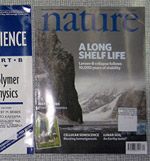Comparing created vs. natural wetlands in carbon sequestration
 Restoration,
Restoration,  Wetland
Wetland A new study by researchers at Ohio State University finds that created wetlands serve as a poor substitute for natural wetlands in terms of sequestering carbon.
Katie Hossler and Virginie Bouchard compared the soil and plant characteristics of natural and created depressional wetlands in central Ohio. They found that created wetlands contained significantly less soil organic carbon and plan biomass than natural wetlands.
They also used modeling to project the trajectory of the created wetlands in terms of their soil and vegetation development. The researchers predicted that it would take the created wetlands 300 years to accumulate the soil organic carbon of natural wetlands and 500 years to accumulate the biomass. These findings are consistent with past studies also showing a slow development of created wetland characteristics and function.
This is problematic in terms of carbon sequestration. Wetlands store the highest amount of carbon per area of any terrestrial ecosystem. When wetlands are converted for agriculture or development, the stored carbon is largely released as C02 to the atmosphere. Newly created wetlands intetended to replace those destroyed clearly are not an equal substitute for re-sequestering the carbon - at least not for a really long time.
One of the main objectives of the study was to understand what mechanisms might be influencing the slow accumulation of soil organic carbon. The researchers found support that poor soil structure - i.e soil aggregation, texture, and bulk density - may be a limiting factor.
This study, and others like it, have direct implications for laws like the Clean Water Act aimed at maintaining a no net-loss of wetlands. Under the Clean Water Act applicants can potentially obtain permits to destroy wetlands if they create new wetlands to offset the loss.
As the study shows, newly created wetlands may not attain equivalent function as natural wetlands for a very long time. This provides support for setting replacement ratios much greater than 1:1.
The trajectory for wetland development can theoretically be used to help calculate an appropriate mitigation ratio. For example the researchers estimated, based on the trajectory modeled in the study, that we would need to set a replacement ratio of at least 2.7:1 if we wanted the cumulative carbon stored in the 0-5cm soil layer of the created wetlands to be equal to natural wetlands within 50 years. The ratio would be higher if we wanted to attain equivalency faster.
The researchers caution though that gaps in data make it difficult at this point to nail down the exact trajectory of development - it could be faster or slower. Alternatively, created wetlands may not be on a trajectory to reach natural conditions at all - i.e. limiting factors may keep them from ever reaching that state as Zedler and Callaway (1999) have suggested.
Given the uncertainty, the authors recommend that, "Wetland mitigation policy should heed the admonition of Zedler and Callaway (1999) and be conservative by maintaining a more restrictive permitting process and requiring higher mitigation ratios"
--by Rob Goldstein
Hossler, K., & Bouchard, V. (2010). Soil development and establishment of carbon-based properties in created freshwater marshes Ecological Applications, 20 (2), 539-553 DOI: 10.1890/08-1330.1




Reader Comments